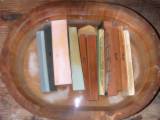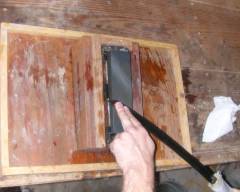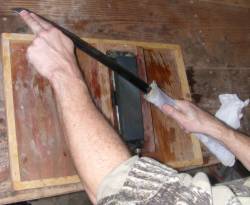Sword Sharpening
Be very careful when sharpening katana. Please don't think about
sharpening a sword that could be a valuable heirloom. You could be destroying an
irreplaceable piece of history and costing yourself hundreds of thousands. A
Practical Katana
or rusty gunto is a good place to start. Practicing with 2000 grit or finer
stones makes it harder to destroy the geometry of the blade, but you should
expect to destroy the first blades you try to sharpen.
Nihonzashi LLC, its employees, and associated
companies are not responsible for any injury, damage or loss incurred by
following any advice given on this site. Katana are dangerous objects and
the utmost care should be given when working with them.
The first thing everyone asks is what grit stones are used to polish or
sharpen a sword. What could be easier than selecting grit? Is that US, European,
English, or Japanese grit? Grit specified the mesh used to separate the abrasive
particles, but everyone uses a different standard and they don't compare well.
Things really fall apart at the finer grits since the US standard switches from
grit to particle size in microns. The following table will give you some clues
on how to relate the different standards. From this point I will use the
Japanese grit since I use Japanese water stones graded by this standard.
Equivalent Grit Table
Particle
Size
(Microns) |
US
Grit |
Japanese
Grit |
Examples |
| 0.5 |
12000 |
25000 |
Chromium Oxide Polishing Compound, Moor
White Ceramic |
| 1 |
5000 |
10000 |
Honyama Awasi (Brown Stone), Linde C
Compound (Aluminum Oxide Powder) |
| 2 |
3000 |
6000 |
Karasu (Blue Stone), Awasi Toshi |
| 3 |
2000 |
4000 |
Uchigumori, Extra Fine White Ceramic, Green
Chrome Rouge, Spyderco Extra Fine Ceramic |
| 6 |
1200 |
2500 |
Ao-To (Blue Stone), Spyderco Fine Ceramic |
| 10 |
1000 |
2000 |
Hard Black Arkansas, Extra-Fine Diamond
Hone, Lansky Ultra-Fine Hone |
| 15 |
800 |
1500 |
Koma-Nagura, Hard White Arkansas, Extra Fine
Diamond, Medium Ceramic, Moor Black Ceramic |
| 20 |
600 |
1000 |
Soft Arkansas, Lansky Fine Hone, Ultra Fine
Scotch-Brite Pad, Spyderco Medium Ceramic |
| 25 |
480 |
800 |
Chu-Nagura, Washita Stone, Fine
Diamond |
| 35 |
320 |
500 |
Kaisei (Natural Sandstone), Fine India,
Medium Diamond, Super/Extra Fine Scotch-Brite
Belt/Pad |
| 45 |
280 |
400 |
Medium India, Fine Crystolon (Silicon
Carbide), Coarse Diamond, Lansky Medium Hone |
| 60 |
220 |
300 |
Binsui Coarse Stone, Extra Coarse Diamond
Hone, Very Fine Scotch-Brite Belt/Pad |
| 80 |
180 |
260 |
Fine Scotch-Brite Belt/Pad |
| 90 |
150 |
220 |
Medium Crystolon (Silicon Carbide), Coarse
India, Medium Scotch-Brite Belt/Pad |
| 110 |
120 |
180 |
Arato (Natural Sandstone Or Carborundum),
Lansky Course Hone |
| 150 |
100 |
150 |
Coarse Crystolon (Silicon Carbide) |
| 180 |
80 |
90 |
Lansky Extra Coarse Hone, Coarse Scotch-Brite
Belt/Pad |
A series of stones ranging from about 800 to 12000 grit are used to sharpen
blades in good shape. If a blade is badly shaped or has chips to remove, stones
down to 80 grit can be used. Don't jump too far between grits or you will be
unable to remove surface scratches.
Japanese water stones are either natural or artificial. Natural stones can be
quite expensive, but artificial stones can be used for sharpening polish. About
half the stone used in a full cosmetic polish can also be artificial, but some
steps require specific natural stones. Artificial stones use a graded abrasive
suspended in either a clay or ceramic media. The stones use water as a
lubricant. Even the inexpensive stones can run $50 each.
 Japanese
water stones need to be soaked in water to work properly. Stones take from 5 to
20 minutes to become saturated depending upon the stone. While some stones can
be stored in water others must be stored dry. I store all my stones dry and soak
them for 20 minutes to simplify things. I put about a quarter cup of sodium
bicarbonate in the water. Baking soda will change the pH of the water and keep
your sword from rusting while you are sharpening it. Some stones like those from
Debado should not be soaked but simply sprinkled with water before using.
These stones will deteriorate if soaked. Japanese
water stones need to be soaked in water to work properly. Stones take from 5 to
20 minutes to become saturated depending upon the stone. While some stones can
be stored in water others must be stored dry. I store all my stones dry and soak
them for 20 minutes to simplify things. I put about a quarter cup of sodium
bicarbonate in the water. Baking soda will change the pH of the water and keep
your sword from rusting while you are sharpening it. Some stones like those from
Debado should not be soaked but simply sprinkled with water before using.
These stones will deteriorate if soaked.
Japanese water stones constantly wear down during use. This is normal and
helps maintain an aggressive cutting surface. Some stones wear down quite
quickly while other stones are quite stable. Stones used to sharpen a sword
should be slightly convex and have rounded corners. The stones will become
concave (hollowed out) during use so they should be reshaped before or after
each use. Special stones are available for keeping your stones true, but I just
use each stone to flatten the next finer grit stone when I switch grits. Keeping
the edges rounded or beveled will keep the stone from fracturing and help keep
you from grinding a grove in your blade.
 Being
a westerner with a bad back, I sharpen swords standing. I use a custom wood
platform on my workbench to secure the stones to. Some stones are already
attached to bases, and I use one of those standard rubber bases for unmounted
stones. You need a sturdy platform that stands up to the water. I used a
platform that fit over the kitchen sink when I was single, but a couple of
buckets for water keep me out of trouble now. You might prefer clamping down
your stones and base, but I find it is unnecessary. Being
a westerner with a bad back, I sharpen swords standing. I use a custom wood
platform on my workbench to secure the stones to. Some stones are already
attached to bases, and I use one of those standard rubber bases for unmounted
stones. You need a sturdy platform that stands up to the water. I used a
platform that fit over the kitchen sink when I was single, but a couple of
buckets for water keep me out of trouble now. You might prefer clamping down
your stones and base, but I find it is unnecessary.
You might have to straighten the blade before you sharpen it. This is your
last chance. Once you start sharpening, the geometry will be lost. Straightening
a sword is an art in itself. The simplest method but hardest to master is simply
bending it over your knee after sighting down it's length. There are slotted
wood sword straightening tools available that allow you to isolate the bend
easier. Whatever method you choose, just remember to take your time.
 The
sword should be disassembled and the bare blade sharpened. Even the habaki
should be removed. I use a piece of an old towel about 1x1 foot wrapped around
the blade to provide a good grip. It has to be tight so it does not slide (and
slice). When I'm working the monouchi I use my right hand to grip the sword and
my left hand to counter the weight of the sword and steady the kissaki. Be
careful of slipping your left hand off the blade or you could loose a few
fingers. Make sure to wipe off any oil. I use two pieces of towel to grip the
sword with both hands when working on other parts of the blade. Remember that it
is easy to cut yourself badly when sharpening a sword. The
sword should be disassembled and the bare blade sharpened. Even the habaki
should be removed. I use a piece of an old towel about 1x1 foot wrapped around
the blade to provide a good grip. It has to be tight so it does not slide (and
slice). When I'm working the monouchi I use my right hand to grip the sword and
my left hand to counter the weight of the sword and steady the kissaki. Be
careful of slipping your left hand off the blade or you could loose a few
fingers. Make sure to wipe off any oil. I use two pieces of towel to grip the
sword with both hands when working on other parts of the blade. Remember that it
is easy to cut yourself badly when sharpening a sword.
The
blade should pass over the stone using a uniform even stroke. This is polishing
and not grinding! I use both the forward and backward movement to do the work.
Go slow and inspect the blade often. Don't worry about how the edge feels. Just
make sure you have worked the stone over the entire surface of the blade while
maintaining the surface geometry. A good light source is essential to seeing
where you have missed. Remember that you are not sharpening the edge. You are
removing metal until the edge is exposed.
 |
 |
The first stone should be used until the scratch pattern just reaches the
edge. The only exceptions are when removing chips or when the edge has been
flattened. The geometry should be established with the coarsest stone and
subsequent stones should just refine the surface. The angle of the scratch
pattern of each stone can be varied to make sure all the scratches from each
stone are removed by the next. Holding the blade up to the light will reveal
scratches from previous stones cutting across the pattern. Cosmetic polishes
alternate the pattern by 90 degrees to make sure every scratch is removed.
The most common mistake is paying too much attention to the edge. All your
attention should be on the surface of the blade. The surfaces must be removed to
reveal the edge. The first stone is key. The surfaces should be worked until the
scratch pattern reaches the edge while maintaining the desired surface geometry.
You must keep working with the first stone until the scratch pattern reaches the
edge. There may be only a very thin polished surface that reflects the light, so
look very carefully. If the edge has been flattened or chipped, you need to
continue past this point.
Once I have established the geometry with the coarsest stone, I use 100
strokes of each stone on both sides of the blade to refine the surface. I use
long strokes that cover about 15 inches of blade. I find the geometry comes out
more uniform this way. That also means that the entire monouchi can be covered
in a single stroke. The blade is rotated very slightly to cover the entire
surface from the shinogi to ha.
It is key to not round over the shinogi. This is the line that runs down the
length of the blade delineating the cutting surface. The blade will need to be
worked right up to the shinogi line, but it is very easy to turn the blade too
much and destroy the geometry of the blade. The blade has a tendency to roll
over and round the shinogi due to its curvature. You can hear when the stone is
working the shinogi or ha. The tone of the scraping changes slightly as you
reach the edge. Be careful!
Slurry is formed on the top of the stone as it breaks down. This paste acts
as a lubricant and as an abrasive. The stone needs to be periodically re-wetted.
Use water with dissolved baking soda to keep the stone wet. Don't wash the paste
off the stone. Use your hand to dip water onto the stone and keep the blade
clean. A small rag can be used, but be careful not to leave thread or other
pieces of debris on the stone or blade. You will need to switch water when you
switch stones or the coarse grit in the water will leave scratches in the blade.
The finer stones need to have a paste formed with a nagura stone to work
properly. The nagura stone is soaked with the water stones and rubbed on the top
of the finish stones to form a paste.
The worst thing you can possible do is using a belt sander, orbital sander,
or grinder on your sword. That is the fastest possible way to turn that sword
into junk. Power tools can quickly remove the temper or destroy the geometry of
the blade. Orbital sanders destroy the geometry by rounding over the ha and
shinogi. I use Delta and Makita wet grinders to reshape badly chipped blades,
but they need allot of practice to use. The grinding wheels move slow and are
water cooled so the blade does not heat up.
Some people use progressively finer grits of silicon carbide sandpaper to
sharpen swords. I have no problem with that, but I personally don't use that
method. I'll keep my water stones and let others do their own thing. You can get
silicon carbide and diamond lapping film that covers the same abrasive grit
range as Japanese water stones.
You can get a wide variety of sharpening systems designed for knifes. These
jigs have one big problem. They are all intended to create an edge with a single
angle. A katana should have a slightly curved continuous surface from the ha to
shinogi. It is not a big knife and can not be sharpened like one. You can get
more data about the geometry of a katana by checking out the edge geometry
|

